Accepted Scientific Name: Parodia schumanniana (Nicolai) F.H.Brandt
Kakteen Orch. Rundschau 1982(4): 62 (1982)
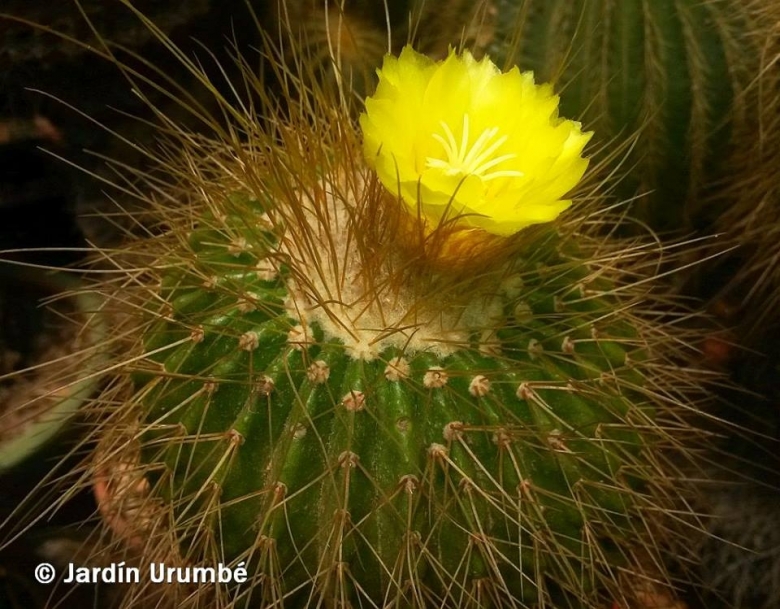
Eriocactus schumannianus (Parodia schumanniana) Photo by: Alexander Arzberger
Origin and Habitat: Brazil, southern Paraguay (Paraguarí and Guairá departments), and north-eastern Argentina ( Misiones: Santa Ana, Teyucuaré, departments). Parodia schumannianaSN|1141]]SN|1141]] is abundant where it occurs, but it is sparsely distributed (extent of occurrence is 16 km2).
Altitude: It occurs at elevations between 300 and 700 m above sea level.
Habitat and Ecology: This species grows in open areas in deciduous rainforests on steep hills on granite and sandstone slag heaps. Their bodies are often overgrown with red and yellow shrub lichens — a sign of the high humidity in the air. Generation length is 5 years. In Brazil the major threats are dam construction and landslides resulting from the erosion caused by agriculture. In Paraguay the major threat is illegal collecting.
Synonyms:
See all synonyms of Parodia schumanniana
back
Accepted name in llifle Database:Parodia schumanniana (Nicolai) F.H.BrandtKakteen Orch. Rundschau 1982(4): 62 (1982)Synonymy: 24
Accepted name in llifle Database:Parodia schumanniana subs. claviceps (F.Ritter) Hofacker & P.J.BraunCactaceae Consensus Init. 6: 12. 1998Synonymy: 5
back
Description: Parodia schumannianaSN|1141]]SN|1141]] is one of the larger species of the genus, with a dark green, rounded body densely clothed with yellowish to brownish spines growing up to 1,8 metres high. Large yellow blooms develop in summer at the crown of the plant and are followed by round green fruit. Two subspecies are recognized, the nominate form and the smaller subsp. claviceps (F.Ritter) Hofacker & P.J.Braun.
Habit: Plants usually solitary, shortly columnar.
Stem: Depressed spherical as a young plant, with apex more or less inclined, becoming cylindrical with age, bright to dark green, mostly 0,5-1 m hight, occassionally up to 1,8 m high and 15-25(-30) cm in diameter (flowering when much smaller).
Ribs: 21-48 (fewer in immature specimens), well defined, straight, acute, not tubercled.
Areoles: Very woolly apically, later less so.
Spines: Bristle-like, straight to slightly arched, golden yellow to brown or reddish, later grey Radial and centrals similar flexible and unequal.
Central spines: (1-)3-4, sometimes absent, 10-30 mm long.
Radial spines: Mostly 4, in two pairs, 7-50 mm long.
Flowers: Apical, funnel-shaped lemon yellow to golden yellow, 4-4.5 cm long, 4.5-6.5 cm in diameter; pericarpels and floral tubes, about 2-2,5 cm long, densely clothed with wool and bristles. Stigma-lobes cream coloured.
Fruits: Globose to ovoid, brownish, with dense wool and bristles, dry at maturity, 1-1.5 cm in diameter.
Seeds: Bell shaped, widest at hilum, shiny reddish brown, nearly smooth.
Subspecies, varieties, forms and cultivars of plants belonging to the Parodia schumanniana
 Parodia ampliocostata (F.Ritter) F.H.Brandt: has more ribs, more spines, multiple central spines, of which the lowest one conspicuously longer and pale yellow anthers. Distribution: Cordillera de los Altos, Paraguarí, Paraguay.
Parodia ampliocostata (F.Ritter) F.H.Brandt: has more ribs, more spines, multiple central spines, of which the lowest one conspicuously longer and pale yellow anthers. Distribution: Cordillera de los Altos, Paraguarí, Paraguay. Parodia grossei (K.Schum.) F.H.Brandt: has stems to 1.7 m high and 30 cm thick, 3-7 long bristly white (or brownish) spines the longer one 4 cm long. Distribution: between Carepegua and southeast of the Cerro Acahay, Paraguarí, Paraguay.
Parodia grossei (K.Schum.) F.H.Brandt: has stems to 1.7 m high and 30 cm thick, 3-7 long bristly white (or brownish) spines the longer one 4 cm long. Distribution: between Carepegua and southeast of the Cerro Acahay, Paraguarí, Paraguay. Parodia grossei var. aureispina (F.Ritter) F.H.Brandt: has stems to 1 m high and 20 cm thick, 8-11 long bristly golden yellow to reddish yellow spines the lowest the longer. Distribution: Cerro Acati, Colonia Indipendencia, Depart. Guairá and Cerro Pelado near Villarica.
Parodia grossei var. aureispina (F.Ritter) F.H.Brandt: has stems to 1 m high and 20 cm thick, 8-11 long bristly golden yellow to reddish yellow spines the lowest the longer. Distribution: Cerro Acati, Colonia Indipendencia, Depart. Guairá and Cerro Pelado near Villarica. Parodia schumanniana (Nicolai) F.H.Brandt: up to 1,8 m tall, areoles 7-15 mm apart, and 0-1 central spine. Distribution: Paraguay and north-eastern Argentina.
Parodia schumanniana (Nicolai) F.H.Brandt: up to 1,8 m tall, areoles 7-15 mm apart, and 0-1 central spine. Distribution: Paraguay and north-eastern Argentina.- Parodia schumanniana subs. claviceps (F.Ritter) Hofacker & P.J.Braun: less than 50 cm tall, areoles only 3-4 mm apart, and 1-3 central spines. Distribution: Rio Grande do Sul, Brazil.
Bibliography: Major references and further lectures
1) Edward Anderson “The Cactus family” Timber Press, Incorporated, 2001
2) James Cullen, Sabina G. Knees, H. Suzanne Cubey "The European Garden Flora Flowering Plants: A Manual for the Identification of Plants Cultivated in Europe, Both Out-of-Doors and Under Glass" Cambridge University Press, 11/Aug/2011
3) Pin, A., Oakley, L., Larocca, J. & Machado, M. 2013. Parodia schumanniana. In: IUCN 2013. “IUCN Red List of Threatened Species.” Version 2013.2. <www.iucnredlist.org>. Downloaded on 06 March 2014.
4) David Hunt, Nigel Taylor “The New Cactus Lexicon” DH Books, 2006
5) Friedrich Ritter “Kakteen in Suedamerika: Ergebnisse Meiner 20 Jaehrigen Feldforschungen” F. Ritter Selbstverlag, 1979
6) Krainz, Hans (Hrsg.) “Die Kakteen” 1957-1975 Franckh'sche Verlagshandlung
7) Hiroshi Hirao “Colour encyclopaedia of cacti” Seibundo Shinkosha, 1979
8) Haustein, Erik. “Der Kosmos-Kakteenführer.” Kosmos / Gesellschaft der Naturfreunde., Stuttgart, 1983
9) Mariella Pizzetti, Giuseppe Mazza “Piante grasse: le cactacee” A. Mondadori, 1985
10) Roberto Kiesling, Omar E. Ferrari “Cien cactus argentinos” Editorial Albatros, 2005
11) Barbara Segall “Botanica: the illustrated A-Z of over 10,000 garden plants and how to cultivate them” Mynah, 1997
12) Hans Hecht “Cacti & succulents” Sterling Pub. Co., 1997
13) Urs Eggli, Leonard E. Newton “Etymological Dictionary of Succulent Plant Names” Springer, Berlin/Heidelberg 2010
14) [Ernst August Nicolai] “Echinocactus Schumannianus Nicolai” In: Monatsschrift für Kakteenkunde. 3:12, 175 1893
15) F. H. Brandt “Die Gliederung der Gattung Parodia Spegazzini.” In: Kakteen- und Orchideen-Rundschau. 7: 4, 62 1982
16) H. Quehl “Neuheiten (Fortsetzungund Schluß aus No. 3)”. In: Monatsschrift für Kakteenkunde. 9: 5 1899
 Habitat 570 m asl. (Parodia schumanniana) Photo by: Alexander Arzberger
Habitat 570 m asl. (Parodia schumanniana) Photo by: Alexander Arzberger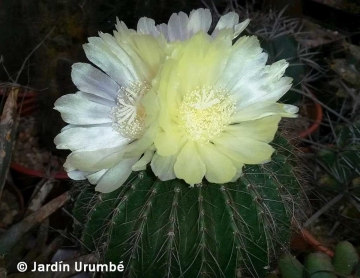 Eriocactus schumannianus (Parodia schumanniana) Photo by: Alexander Arzberger
Eriocactus schumannianus (Parodia schumanniana) Photo by: Alexander Arzberger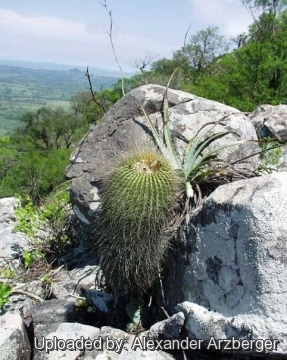 Eriocactus schumannianus (Parodia schumanniana) Photo by: Alexander Arzberger
Eriocactus schumannianus (Parodia schumanniana) Photo by: Alexander Arzberger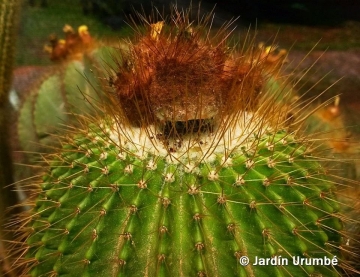 Eriocactus schumannianus (Parodia schumanniana) Photo by: Alexander Arzberger
Eriocactus schumannianus (Parodia schumanniana) Photo by: Alexander Arzberger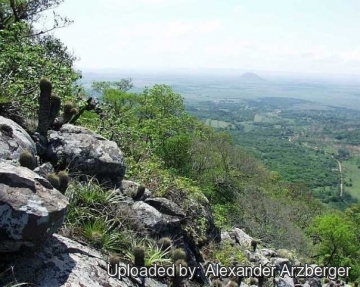 Habitat 570 m asl. (Parodia schumanniana) Photo by: Alexander Arzberger
Habitat 570 m asl. (Parodia schumanniana) Photo by: Alexander Arzberger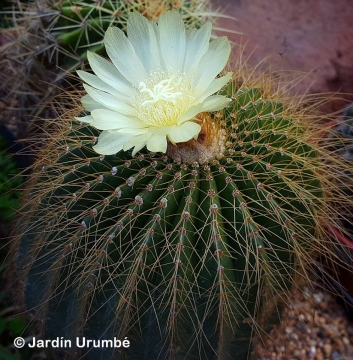 Eriocactus schumannianus (Parodia schumanniana) Photo by: Alexander Arzberger
Eriocactus schumannianus (Parodia schumanniana) Photo by: Alexander ArzbergerCultivation and Propagation: Frost Tolerant as low as -4°C (or possibly colder) but in cultivation it is best to avoid any frost when during the winter the temperature can go down to 2° C without any harm so long as the compost is very dry. During the summer it is best to keep the plants outside where the temperature can rise to over 30 C with no harm to the plant.
Allows good drainage and use a an open and free draining mineral compost that allows therefore roots to breath.
They like only a short winter's rest and should be kept almost completely dry during the winter months, If the soil is allowed to be dry for too long root loss could follow but equally the same result would occur if the plants are both wet and cold. From March onwards the plant will begin to grow and watering should be increased gradually until late May when the plant should be in full growth.
Water regularly during the summer so long as the plant pot is allowed to drain and not sit in a tray of water. During hot weather you may need to water the plants more frequently so long as the plant is actively growing. From late September watering should be reduced to force the plant to go in to a state of semi dormancy, by October you should be back in to the winter watering regime.
Need full sun avoiding only the harshest summer sun, if kept too dark they may become overly lush and could be prone to rotting due to over watering, they will also be shy to produce flowers.
Feeding may not be necessary at all if the compost is fresh then, feed in summer only if the plant hasn't been repotted recently. Do not feed the plants from September onwards as this can cause lush growth which can be fatal during the darker cold months.
Repotting should be done every other year or every three years, annual potting is not necessary. Do not be tempted to over pot as this will cause the unused compost to go stagnant and you may loose the plant.
Propagation: Seed sowing and cuttings.

















